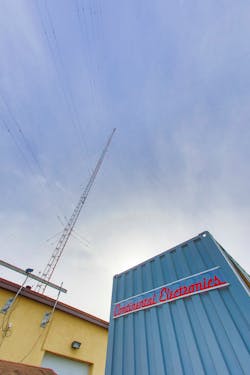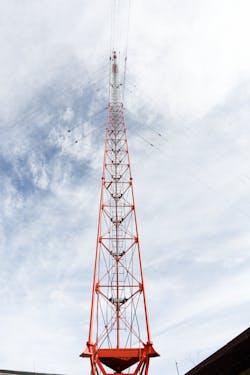Public-private partnership to launch eLORAN technology to back-up and accompany GPS
MIDDLEBURG, Va., - Global Navigation Satellite Systems (GNSS) like the Global Positioning System (GPS) and its comparable GNSS systems have revolutionized the way both the military and civilians get from "point a" to "point b."
While the space-based navigation systems put into orbit by the United States, Russia, China, the EU, India, and Japan were once thought to be relatively safe from harm by opposing nations, militaries have since shown the ability to shoot down satellites in addition to jamming signals terrestrially. In fact, India joined the U.S., China, and Russia just last year in shooting down one of its own satellites.
“It’s as significant as India’s first nuclear blast,” Saurav Jha, the editor in chief of the Delhi Defense Review, told the New York Times in March 2019. “The militarization of space is underway, whether anybody likes it or not."
Should GPS be taken offline or somehow interfered by a nefarious actor, the U.S. Department of Defense (DOD) would have to look to its past to ensure navigation, location, and timing functions stay online.
Thanks to a public-private partnership, a much-improved version of a technology that was birthed during World War II can complement GPS and act as a back-up if needed.
LORAN - or, LOng RAnge Navigation - got its start during WWII and utilized low-frequency hyperbolic radio navigation to keep convoys on the move across the Atlantic and to aid pilots and ships in the Pacific Theater. This was done by figuring out how long it took to transmit between the "master" radio transmitter and the signal at the second station.
In the intervening years, the United States Coast Guard took over an improved system, dubbed LORAN-C, starting in 1958. In 2009, amidst the Great Recession, President Barack Obama declared the LORAN program obsolete and announced plans to terminate it. In 2010, the USCG began shutting down the system.
Just five years later, the U.S. House of Representatives reopened discussions of an enhanced version of LORAN -eLORAN. In 2018, President Donald Trump signed into law the National Timing Resilience and Security Act, as part of the Frank LoBiondo Coast Guard Authorization Act, which mandates the Secretary of Transportation to establish and sustain a land-based timing system to provide a back-up to GPS, namely "to ensure the availability of uncorrupted and non-degraded timing signals for military and civilian users in the event that GPS timing signals are corrupted, degraded, unreliable, or otherwise unavailable." This law was co-sponsored by Sen. Ted Cruz (R-TX) and Sen. Ed Markey (D-MA) in the Senate and Cong. John Garamendi (D-CA) and Cong. Duncan Hunter (R-CA) in the House.
Bridge Littleton and Daniel Olmes, co-founders and co-presidents of Hellen Systems, based in Middleburg, Va., spoke about the efforts their company and public/private partners have made to launch eLORAN.
"Our focus was really building a world-class team to then be able to go and deploy this system through a future partnership with the U.S. government and put the system back on air," said Hellen's Littleton. "What we are really focused on is helping the government reconstitute and deploy eLORAN as a resilient co-primary, independent backup for GPS."
Beyond GPS
Both civilian and military consumers utilize GPS via myriad devices, but as noted, the SATCOM system is vulnerable to interference."It's wonderful," Littleton says of GPS. "It's just got this one weakness - it's 12,000 miles in space. That's just what it's going to be. So, what is great about eLORAN is there are no common failure modes between GPS and eLORAN. GPS is space based, eLORAN is terrestrial based. GPS is high frequency, eLORAN is low frequency – it’s 90 to 110 kilohertz. GPS is low power; eLORAN is high power. GPS can't penetrate buildings and go indoors, eLORAN can because it's a low frequency wave and its high power. It can penetrate through buildings, can go underground, can go through tunnels, can go under water and is unaffected by space phenomenon."
According to Littleton and Olmes, the eLORAN signals are three to five million times stronger than GPS/GNSS and have 99.999% availability and reliability. Each tower has a 1,200-mile signal range. Its spectrum of 90-110 kHz is internationally protected, and eLORAN is deployable, so military branches can set up the system at their bases around the world.
For the eLORAN system to cover the contiguous United States, six towers are needed for timing applications and 19 are need for position and navigation.
In addition to positioning, navigation, and timing, the LORAN Data Channel (LDC) acts as a channel within eLORAN and enables one-way data communication over 1,200 miles, with nearly 100% of its strength at that distance. The LCD features include time of day and clock corrections; encrypted, mission specific data messaging/SW updates; authentication of eLORAN broadcasts (anti spoofing); secure, un-jammable command and control; and penetrates all structures in all weather conditions.
Partnering with the United States federal government and Hellen Systems to develop eLORAN is L3Harris Technologies in Melbourne, Fla.; Microchip Technologies in Chandler, Ariz., Continental Electronics Corporation in Dallas; and NeoTech Natel Epic OnCore in Chatsworth, Calif.
L3Harris is acting as the eLORAN system integrator; Microchip is providing frequency and timing engineering expertise and system hardware solutions; Continental Electronics is providing eLORAN transmitters; and NeoTech is providing eLORAN contract manufacturing services.
In addition, Booz Allen Hamilton in McLean, Va., is providing management services and cyber security as well as adoption integration, and Crown Consulting Inc., in Arlington, Va., is providing training and operation support.
It is envisioned that eLORAN could be a subscription service much like the Automatic Dependent Surveillance-Broadcast (ADS-B) system utilized by the Federal Aviation Administration.
To learn more about the eLORAN system and the public/private partnership, please visit https://hellensystems.com/, or contact Hellen Systems by visiting https://hellensystems.com/contact/.
About the Author

Jamie Whitney
Jamie Whitney joined the staff of Military & Aerospace Electronics and Intelligent Aerospace. He brings seven years of print newspaper experience to the aerospace and defense electronics industry.
Whitney oversees editorial content for the Intelligent Aerospace Website, as well as produce news and features for Military & Aerospace Electronics, attend industry events, produce Webcasts, oversee print production of Military & Aerospace Electronics, and expand the Intelligent Aerospace and Military & Aerospace Electronics franchises with new and innovative content.

